
Above: On the far right is the war hero, Manta Singh. Standing next to him is the man he saved - Captain Henderson.



History
Manta Singh and The Battle of Neuve Chapelle
THE COMMONWEALTH WAR GRAVES COMMISSION
This year marks the centennial of the commencement of the First World War. The following is the saga of Sardar Manta Singh who gave his life defending the Poppy fields of France.
Manta Singh was born in 1870 near Jullundur, in Punjab.
As soon as he left school he joined the 15th Ludhiana Sikhs, an infantry regiment of the British-Indian Army.
At the start of the First World War, the regiment became part of the 3rd (Lahore) Division, sent to reinforce the British Expeditionary Force (BEF) fighting in France.
By late autumn of 1914, one in every three soldiers under British command in France was from the subcontinent .... and a majority of them were Sikhs.
After long months of trench warfare, in March 1915, Manta Singh's regiment prepared to engage in the first major British offensive on the Western Front, the Battle of Neuve-Chapelle. Half of the Commonwealth fighting force, 20,000 men, were from the subcontinewnt, mostly Sikhs.
General John French, commander-in-chief of the BEF in France at this time, planned to "take the village of Neuve-Chapelle, which formed a German salient (bulge) in the British line, and if possible to take Aubers Ridge, a modest but nevertheless important observation post overlooking the plain. French also thought it might well be possible to get behind the German front and threaten the defences of nearby Lille.
On 10 March four divisions, comprising 40,000 men, gathered on a sector of the front which was only three kilometres wide. The infantry attack was preceded by heavy but concentrated shelling from 342 guns, guided by reconnaissance planes of the Royal Flying Corps.
In thirty-five minutes, the bombardment consumed more shells than the British Army used in the whole of the Boer War fifteen years earlier, a clear example of the growing industrialization of the Great War.
While the British and the Indian Corps advanced rapidly through the lightly-defended village, the Garhwal Rifles suffered heavy losses as they attacked a part of the German line left untouched by the bombardment.
After an initial success, in a matter of hours, the British became paralysed by poor communications and a lack of munitions, and their advance ground to a halt.
Bringing in reinforcements from Lille, Crown Prince Rupert of Bavaria launched a counter-attack on 12 March. British soldiers attempting to take Aubers Ridge came up against undamaged barbed wire entanglements and their losses were enormous."*
It was in this chaotic field of battle that the 15th Ludhiana Sikhs fought. Manta Singh witnessed an English comrade, Captain Henderson, suffering serious injury. Manta Singh pushed him to safety in a wheelbarrow he found in no-man's land but he himself was severely injured while carrying out this selfless rescue.
Fighting ceased on 13 March with British gains limited to an area two kilometres deep and three kilometres wide for a loss of 7,000 British and 4,200 Indian soldiers -- mostly Sikhs -- either killed or wounded.
The Germans suffered similar losses and 1,700 of their soldiers had been taken prisoner.
A breakthrough had been made but could not be exploited. This tragic scenario was repeated throughout the front until the spring of 1918.
General French attributed his failed offensive to a lack of shells for the preliminary bombardments. From that moment on, considerable shelling over several days was carried out prior to any attack despite the fact that it removed the element of surprise. Thanks to such a clear broadcast of intent, the Germans were able to send reinforcements in good time to any sector of the front threatened by an Allied offensive."
* * * * *
Manta Singh may have spent some time at the Royal Pavilion in Brighton, where many of the Sikh wounded from the front-lines were brought for treatment and recuperation.
But it is certain he was treated at the Kitchener Indian Hospital.
Here, sadly, his wounds became infected with gangrene. He was told his legs would have to be amputated to save his life, a thought which filled him with despair.
Subadar Manta Singh of the 15th Ludhiana Sikhs -- son of Sardar Khem Singh, of Salempur, Masandan, Jullundur, Punjab -- died on March 20, 1915 from blood poisoning a few weeks later.
* * * * *
Manta Singh and the injured man he rescued, Captain Henderson, had become firm friends as well as brothers in arms. When Manta Singh died, Henderson ensured that Singh's son, Assa, was taken care of. He encouraged him to join the Sikh Regiment too. Throughout the Second World War, Assa Singh and Henderson's son, Robert, served together, in France, Italy and North Africa.
To this day, the Singh and Henderson families remain close friends. Assa and Robert have passed away, but their sons, Jaimal Singh and Ian Henderson, are in regular contact.
* * * * *
Sardar Manta Singh is remembered with honour at the Patcham Down Indian Forces Cremation Memorial, Brighton, United Kingdom -- close to The Chattri Memorial.
[Courtesy: The Commonwealth War Graves Commission. Edited for sikhchic.com]
March 7, 2014
With many thanks to Prof. Yves Le Maner
Conversation about this article
1: Sandeep Singh Brar (Canada), March 07, 2014, 9:15 AM.
To learn more about Manta Singh and the hospital where he was treated and the Chattri Memorial place where he was cremated, visit the SikhMuseum.com exhibit titled 'Doctor Brighton's Pavilion'. You'll see photographs of Manta Singh's grandson and Captain Henderson's grandson together.
2: Kaala Singh (Punjab), March 07, 2014, 1:22 PM.
This is true Sikhi! Saving lives and doing good to everyone. Making this world a better place for everyone. This is what we call "Sarbat da Bhalla". Proud of such Sikhs.
3: Baldev Singh (Bradford, United Kingdom), March 07, 2014, 6:25 PM.
This is a wonderful story of bravery and selfless service for a country which Manta Singh hardly knew! As Sikhs we need every single story of Sikh sacrifices and valour during the Great War, the First World War of 1914-1918 because it is the centenary and more importantly the Sikhs' awesome contribution to this horrific war has hardly ever been seen in any post-war archive or film shown generally to the British public and the world! This has to change and war heroes like Manta Singh are prime examples of the modern day Sikh Saint-Warrior!


